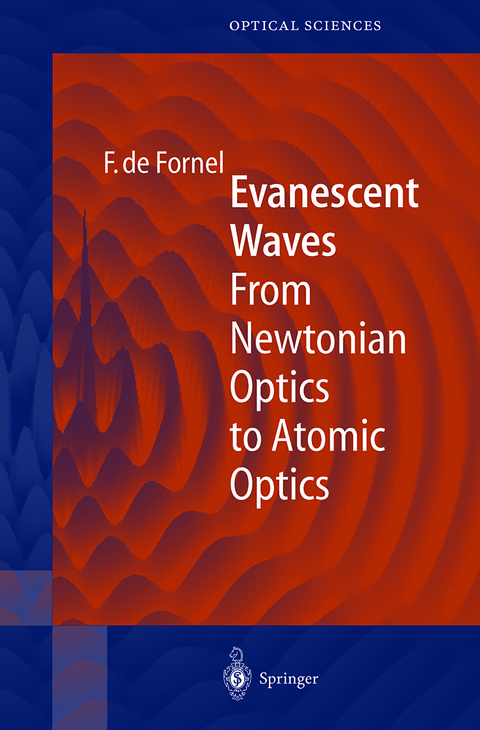
Evanescent Waves
Springer Berlin (Verlag)
978-3-642-08513-0 (ISBN)
'I. The Evanescent Field.- 1. Total Internal Reflection.- 1.1 The Electromagnetic Field at Total Internal Reflection.- 1.1.1 Snell's Law.- 1.1.2 Analysis of Total Internal Reflection on the Basis of Maxwell's Equations.- 1.1.3 Components of the Electric Field in the Second Medium in the z = 0 Plane.- 1.2 Flux of the Poynting Vector Associated with the Evanescent Field.- 1.3 Shifts of the Beams at Total Internal Reflection.- 1.4 Frustrated Total Internal Reflection.- 1.5 Resonant Tunneling Effect.- 1.6 Conclusion.- 2. Diffraction from an Aperture and Dipolar Radiation.- 2.1 Analysis of the Propagation of Light Through an Aperture.- 2.2 Diffraction of Light from a Circular Aperture.- 2.2.1 Diffraction from an Aperture in an Infinitely Thin Plane.- 2.2.2 Diffraction from a Circular Aperture in a Thick Screen.- 2.3 Coupling Between Several Apertures.- 2.4 Dipolar Emission.- 2.4.1 Expression of the Dipolar Field.- 2.4.2 Energy Emitted by a Dipole.- 2.5 Dipolar Emission in the Vicinity of a Surface.- 2.6 Conclusion.- 3. The Evanescent Field in Guided Optics.- 3.1 The Evanescent Field in Planar Optics.- 3.1.1 Analysis of Planar Waveguides.- 3.1.2 Production of Step-Index Planar Waveguides.- 3.2 Confined Waveguides.- 3.3 Optical Fibers.- 3.3.1 Ray-Optical Analysis of the Propagation in Optical Fibers.- 3.3.2 Modes of Step-Index Fibers.- 3.3.3 Modes of Inner-Cladding Fibers.- 3.3.4 Modes of Annular-Core Fibers.- 3.3.5 Modes of Graded-Index Fibers.- 3.3.6 Modes of Polarization-Preserving Fibers.- 3.4 Whispering-Gallery Modes.- 3.5 Band-Gap Photonics Waveguides.- 3.6 Conclusion.- Conclusion of Part I.- II. Delocalized Interaction with the Evanescent Field.- 4. Evanescent-Field Optical-Fiber Couplers.- 4.1 Types of Couplers.- 4.2 Fabrication Techniques of Evanescent-Field Fiber-Optic Couplers.- 4.2.1 Twist-Etched Fiber Couplers.- 4.2.2 Mechanically Polished Fiber Couplers.- 4.2.3 Fused-Tapered Fiber Couplers.- 4.2.4 Comparison Between the Different Types of Couplers.- 4.3 Analysis of the Coupling.- 4.3.1 Coupled Power Between Two Parallel Uniform Fibers.- 4.3.2 Step-Index Fibers.- 4.3.3 Inner-Cladding Fibers.- 4.3.4 Variable-Diameter Couplers.- 4.4 Spectral Filters and Spectral Multiplexers.- 4.5 Polarization Splitters.- 4.6 Production of Modal Filters.- 4.7 Devices Produced from Evanescent-Field Couplers.- 4.7.1 Optical-Fiber Gyroscope.- 4.7.2 Fiber Lasers.- 4.8 Conclusion.- 5. Integrated-Optical Evanescent-Field Couplers.- 5.1 Description of Integrated-Optical Couplers.- 5.2 Analysis of the Coupling Between Two Waveguides.- 5.3 Active Couplers.- 5.4 Coupling from a Fiber to a Planar Waveguide.- 5.5 Integration of a Waveguide and a Photodiode.- 5.6 Conclusion.- 6. Evanescent-Field Waveguide Sensors.- 6.1 General Points on Sensors.- 6.2 Fiber-Optic Sensors.- 6.2.1 Monitoring of a Chemical Reaction by Fluorescence Detection.- 6.3 Integrated-Optical Sensors.- 6.3.1 Analysis of the Sensitivity of Integrated-Optical Sensors.- 6.3.2 Creating the Sensing Region.- 6.3.3 Evanescent-Field Interferometric Sensors.- 6.3.4 Amplification of the Evanescent Field by a Multilayered System and Applications to Biosensors.- 6.4 Conclusion.- 7. Internal-Reflection Spectroscopy.- 7.1 Effect of Index Variations on Total Internal Reflection.- 7.1.1 Effective Thickness.- 7.1.2 Measurement of the Dielectric Constants in an Arbitrary Medium.- 7.2 Spectroscopy Devices Based on Total Internal Reflection.- 7.2.1 Description of Different Systems Generating Total Internal Reflection.- 7.2.2 Description of Internal-Reflection Spectroscopes.- 7.2.3 Quality of the Reflective Element.- 7.2.4 Constraints in the Preparation of the Samples.- 7.3 Atom Spectroscopy in the Vicinity of Interfaces.- 7.4 Conclusion.- 8. Evanescent-Wave Atom Optics.- 8.1 Atomic Interferences.- 8.2 Reflection of Atoms.- 8.3 Deflection of Atoms.- 8.3.1 Deflection Based on the Use of Evanescent Waves Gene
From the reviews of the first edition:
"Evanescent waves play a growing role in many different areas such as guided optics, optical fiber couplers, integrated optical elements, internal reflection spectroscopy, atom optics, dark-field microscopy, and many others. The intent of this book is to describe the near-field associated with different optical systems. ... the author succeeds to give an excellent review of the field and the book is really a unique one. It is intended as a reference for scientist and as an introduction at the graduate level." (A. Tresch, Optik, Vol. 113 (2), 2002)
"Recently the features of the behavior of optical electromagnetic waves close to the surface of solid state in the so-called near-field region, i.e., where the distance to the object remains smaller than the wavelength of the light, attracted much attention. ... The book is illustrated with plenty of examples and is easy to read. It can be a good guide-book for students and postgraduates and is of interest for physicists, theoreticians and experimentalists, newcomers to this field." (A. Bukharaev, Applied Magnetic Resonance, Vol. 21 (2), 2001)
| Erscheint lt. Verlag | 15.12.2010 |
|---|---|
| Reihe/Serie | Springer Series in Optical Sciences |
| Zusatzinfo | XVIII, 270 p. |
| Verlagsort | Berlin |
| Sprache | englisch |
| Maße | 155 x 235 mm |
| Gewicht | 446 g |
| Themenwelt | Naturwissenschaften ► Chemie ► Analytische Chemie |
| Naturwissenschaften ► Physik / Astronomie ► Elektrodynamik | |
| Naturwissenschaften ► Physik / Astronomie ► Festkörperphysik | |
| Naturwissenschaften ► Physik / Astronomie ► Optik | |
| Naturwissenschaften ► Physik / Astronomie ► Thermodynamik | |
| ISBN-10 | 3-642-08513-X / 364208513X |
| ISBN-13 | 978-3-642-08513-0 / 9783642085130 |
| Zustand | Neuware |
| Haben Sie eine Frage zum Produkt? |
aus dem Bereich


